What is endodontic treatment (root canal)?
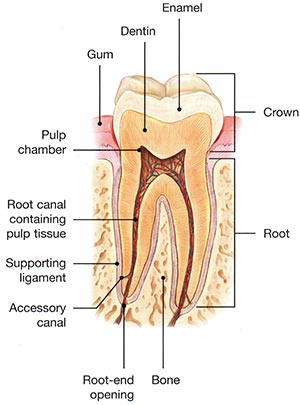 “Endo” is the Greek work for “inside” and “odont” is Greek for “tooth.” Endodontic treatment treats the inside of the tooth.
“Endo” is the Greek work for “inside” and “odont” is Greek for “tooth.” Endodontic treatment treats the inside of the tooth.
To understand endodontic treatment, it helps to know something about the anatomy of the tooth. Inside the tooth, under the white enamel and a hard layer called the dentin, is a soft tissue called the pulp. The pulp contains blood vessels, nerves and connective tissue, and creates the surrounding tissues of the tooth during development.
The pulp extends from the crown of the tooth to the tip of the roots where it connects to the tissues surrounding the root. The pulp is important during a tooth’s growth and development. However, once a tooth is fully mature it can survive without the pulp, because the tooth continues to be nourished by the tissues surrounding it.
Why would I need an endodontic procedure?
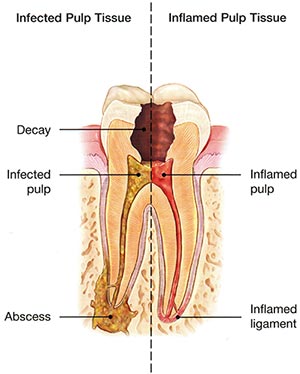 Endodontic treatment is necessary when the pulp becomes inflamed or infected. The inflammation or infection can have a variety of causes: deep decay, repeated dental procedures on the tooth or a crack or chip in the tooth. In addition, a blow to a tooth may cause pulp damage even if the tooth has no visible chips or cracks. If pulp inflammation or infection is left untreated, it can cause pain or lead to an abscess.
Endodontic treatment is necessary when the pulp becomes inflamed or infected. The inflammation or infection can have a variety of causes: deep decay, repeated dental procedures on the tooth or a crack or chip in the tooth. In addition, a blow to a tooth may cause pulp damage even if the tooth has no visible chips or cracks. If pulp inflammation or infection is left untreated, it can cause pain or lead to an abscess.
Signs of pulp damage include pain, prolonged sensitivity to heat or cold, discoloration of the tooth and swelling and tenderness in the nearby gums. Sometimes, there are no symptoms.
How does endodontic treatment save the tooth?
Dr. Shoushtari removes the inflamed or infected pulp, carefully cleans and shapes the inside of the tooth, then fills and seals the space. Afterwards, you will return to your dentist, who will place a crown or other restoration on the tooth to protect and restore it to full function. After restoration, the tooth continues to function like any other tooth.
Will I feel pain during or after the procedure?
Many endodontic procedures are performed to relieve the pain of toothaches caused by pulp inflammation or infection. With modern techniques and anesthetics most patients report that they are comfortable during the procedure.
For the first few days after treatment, your tooth may feel sensitive, especially if there was pain or infection before the procedure. This discomfort can be relieved with over-the-counter or prescription medications. Please follow Dr. Shoushtari’s instructions carefully.
Your teeth may continue to feel slightly different from your other teeth for some time after your endodontic treatment is completed. However, if you have severe pain or pressure, or pain that last more than a few days, please call our office.
Endodontic Procedure
Endodontic treatment can often be performed in one or two visits and involves the following steps:
|
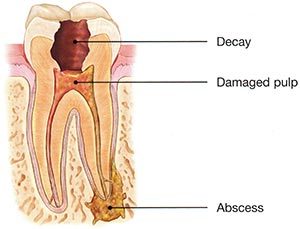 |
|
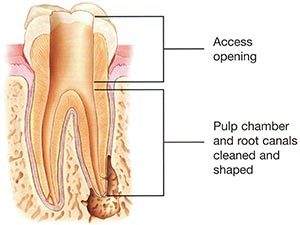 |
|
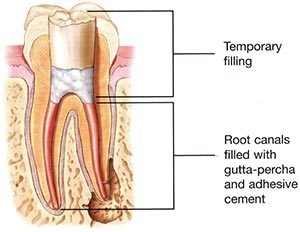 |
|
|
|
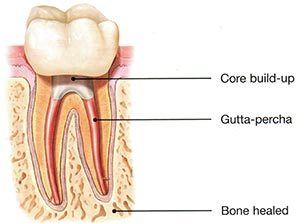 |
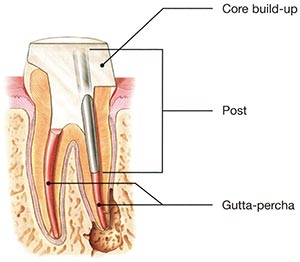 If the tooth lacks sufficient structure to hold the restoration in place, your dentist or Dr. Shoushtari may place a post inside the tooth.
If the tooth lacks sufficient structure to hold the restoration in place, your dentist or Dr. Shoushtari may place a post inside the tooth.
Will the tooth need special care or additional treatment?
You should not chew or bite on the treated tooth until you have had it restored by your dentist. The unrestored tooth is susceptible to fracture, so you should see your dentist for a full restoration as soon as possible. Otherwise, you only need to practice good oral hygiene, including brushing, flossing and regular checkups and cleanings.
Most endodontically treated teeth last as long as other natural teeth. In a few cases, a tooth that has undergone endodontic treatment fails to heal or the pain continues. Occasionally, the tooth may become painful or diseased months or even years after successful treatment. Often when this happens, another endodontic procedure can save the tooth.
What causes an endodontically treated tooth to need additional treatment?
New trauma, deep decay or a loose, cracked or broken filling can cause new infection in your tooth. In some cases, Dr. Shoushari may discover very narrow or curved canals that could not be treated during the initial procedure.
Can all teeth be treated endodontically?
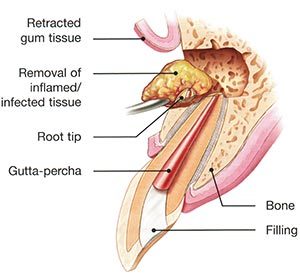
Most teeth can be treated. Occasionally, a tooth can’t be saved because the root canals are not accessible, the root is severely fractured, the tooth doesn’t have adequate bone support or the tooth cannot be restored. However, advances in endodoncits are making it possible to save teeth even a few years ago would have been lost.
What are the alternatives to endodontic treatment?
When the pulp of a tooth is damaged, the only alternative to endodontic treatment is extraction of the tooth. To restore chewing function and to prevent adjacent teeth from shifting, the extracted tooth must be replaced with an implant or bridge. This requires surgery or dental procedures on adjacent teeth. No matter how effective modern tooth replacements are-and they can be very effective-nothing is as good as a natural tooth.